Supporting Leaders at All Levels: ESCEO Exemplifies Commitment to Service, Innovation, and Improved Learning Outcomes for All Children and Adults
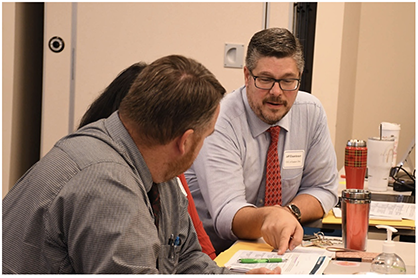
“Our commitment is to individualized success for all children through high quality shared services that are tailored, innovative, and cost effective for our partners,” explained Dr. Traci Hostetler, Superintendent of the Educational Service Center of Eastern Ohio (ESCEO). “What that really means to us, off the script, is that we believe every child deserves an education tailored to meet their specific needs so each of them reaches the point where they become productive, successful, happy members of our society,” she added.
ESCEO, formerly the Mahoning County Educational Service Center (ESC), is located in Canfield, Ohio and is one of 57 ESCs in Ohio. According to the Ohio ESC Association (OESCA), ESCs were originally established as county offices of education in 1914 and were intended to assist school systems with curriculum development, inservice training, and related tasks. More recently, in 1995, Am. Sub. H.B. 117 redefined county offices of education, changing their name to ESCs and encouraging the merger of county offices into regional agencies.

ESCEO is the fiscal agent for State Support Team (SST) Region 5, one of Ohio’s 16 SSTs. It serves local education agencies and others in northeast Ashtabula, Columbiana, Mahoning, and Trumbull counties. “About 20 districts have aligned with us but we work with closer to 30 districts that receive services from our teaching and learning personnel and our career counselors,” explained Hostetler.
ESCEO’s New Partner for Supporting Inclusive Instructional Leadership (IIL)
With a focus this year on building the capacity of school and district leaders across the region, the ESCEO has formed a strategic partnership with the University of Cincinnati Systems Development & Improvement Center (UC SDI). With support from the Ohio Department of Education (ODE), UC SDI provides professional learning to district- and school-level leadership personnel (e.g., principals, teacher leaders, superintendents, central office personnel, leadership teams) to improve their use of inclusive instructional leadership (IIL) practices. Education leaders build this capacity through their participation in statewide initiatives such as the Ohio Leadership for Inclusion, Implementation, and Instructional Improvement (OLi4) and the Ohio Advancing Inclusive Principal Leadership (OH-AIPL).
IIL practices are actions to mobilize a school district – or schools within the district – to provide equitable opportunities to learn for each student while promoting high levels of learning for all students and each subgroup of students.
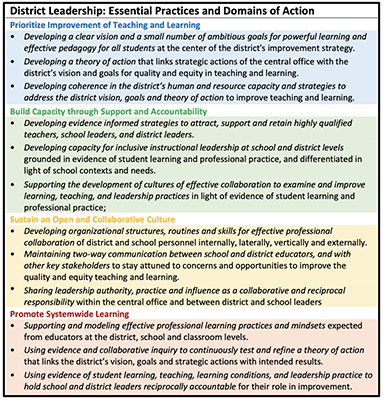
This approach combines instructional leadership with social-justice leadership through the use of four key strategies: (1) prioritizing the improvement of teaching and learning, (2) building capacity through support and accountability, (3) sustaining an open and collaborative culture, and (4) promoting systemwide learning.
Using the OIP to Change Organizational Culture
Ohio’s improvement framework – the Ohio Improvement Process or OIP – combines two components: (1) a five-step process and (2) the use of “nested” leadership team structures at the district, school, and classroom level [i.e., district leadership team (DLT), building leadership team (BLT), and teacher-based teams (TBT)]. When used as intended, the OIP supports shared learning on the part of adults at all levels of the system in order to improve learning opportunities and outcomes for all children.

Hostetler used the OIP in two former districts – as the Director of Teaching and Learning in one district and as Superintendent in the other. “I love this process because it really requires vulnerability and honest reflection, and it builds trust within the organization. Teachers and principals need to know that they’re free from consequences as they study, reflect, try new things, fail, and learn because all of that is important to growth,” explained Hostetler.
“This process really does change the culture of your organization. It has the ability, when led by committed people, to just blossom your entire district,” she added.
Using OIP to prioritize teaching and learning. Ohio’s Leadership Development Framework (BASA, 2022, p. 1) is grounded in several tenets. Among them is the belief that leadership is a shared responsibility involving the use of essential practices directed toward the improvement of instruction with the ultimate aim of increasing student learning.
“I don't think anyone would argue that the role of the building leader is to serve as lead learner in terms of improving student academics and achievement. In the past two years or so with COVID, we’ve seen a concerted effort to not only teach kids at grade level in relation to grade-level standards, but also to catch kids up. If we can look at the silver lining in the pandemic, it's that we are now really putting that pressure on building leaders, on superintendents to focus on student learning and achievement, whether they were more on the managers side or the lifelong learner-leader side,” said Hostetler.
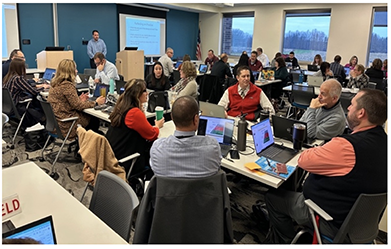
In keeping with ESCEO’s mission, Hostetler and her leadership team help districts use the OIP as a vehicle for meeting the needs of each student, including students identified as having a disability and other struggling learners.
“When we talk about effective teacher-based teams, we see TBT members working together to align their instruction, align homework, and align assessments to increase the depth of knowledge for each child. We know as educators that some children are better at certain things than others. Our prevention and wellness team and our career counselors are able to meet those kids, again, where they are. We are supporting any decision a student makes, whether it is college, career, military, whatever. We are pushing anything that is important to the child, to the students,” explained Hostetler.

Whole child focus leading to postsecondary success. A licensed social worker, Ashley Mariano serves as the Prevention Coordinator and Family and Community Liaison with ESCEO’s Prevention and Mental Wellness Team. In her role, she supports educators and families in addressing social-emotional learning needs of children and youth. “When we look at how to scaffold supports around non-academic needs of our students, we think about those whole child needs – the physical, mental, emotional, behavioral needs of our students.” According to Mariano, support for the whole child provides a strong foundation for academic learning.
“We know all of our students need to have their basic needs met and have that sense of connection and belonging. We're all here rooting for that same thing, those vested interests in attendance, achievement, post-secondary aspirations. And we know that those are going to be better able to be achieved when we're supporting those whole child needs,” offered Mariano.
Sandy Furano, Director of the Mahoning Valley Regional Council of Governments and Career Counseling Services, supports youth in meeting those post-secondary aspirations through strong collaborative relationships with districts served by ESCEO.
Quick OIP Refresh
For an introduction to the Ohio Improvement Process (OIP) and its basic components, see these new OLAC videos by Michele Moore, Director of SST Region 5, operated through ESCEO:
Furano joined ESCEO in 2016 as lead career counselor and has more than 20 years of experience in adult education. She also leads the Mahoning Valley Business Advisory Council (BAC), which is supported by ESCEO and more than 25 area school districts. “The career counseling team focuses on ODE graduation pathways for all students and, for those students who struggle with end-of-course points, we look for other pathways for them to graduate such as building and trades pre-apprenticeships that allow students to be in their home school and earn up to 24 industry recognized credential points during this pre-apprentice,” she explained.
Furano works with the BAC to create other pre-apprenticeship programs that support students in pursuing meaningful postsecondary options. “It's not only building trades; we're looking at manufacturing, information technology, engineering. Even simple things like Microsoft Office, and getting the students an industry recognized credential helps them get those 12 points for that different graduation pathway,” she added.
“This is all about increasing positive outcomes for kids from all these different lenses. Student engagement is a huge part of student success and keeping kids involved in the learning process is necessary for obtaining positive results. The work that Sandy and Ashley are doing is amazing,” said Sheri Lewis, Manager of ESCEO’s Extended Learning and Recovery (ELAR) Grant.
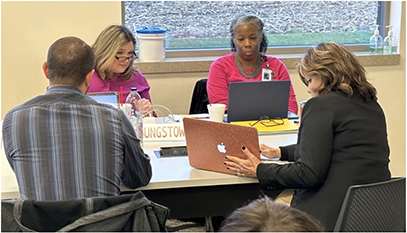
Lewis believes that using OIP structures to prioritize teaching and learning is making a difference for districts in the region. She also recognizes that districts are in “different places in their use of OIP.”
“They’ve all had a toe in the water, if you will, in using the OIP process. Some, very little, and some that could take a leadership role with other districts. So we are across the board in using inclusive leadership practices and working to affect student learning from that leadership role. I think when you look at something that broad-based, you have to tailor it to where districts are in the process and provide the necessary supports,” said Lewis.
Providing Necessary Support Through IIL Professional Learning

Hostetler and her team are providing professional development (PD) to teams from eight districts in Mahoning and Columbiana counties as part of their ELAR Grant. Teams are composed of principals, assistant principals, and central office personnel; a superintendent’s group meets separately in addition to attending some of the team PD.
“What better way to support our districts in improving learning opportunities for all students than by studying what we're doing, analyzing the impact of what we’re doing, capitalizing on the successful practices, and eliminating the practices that don't work. That, in a nutshell, impacts the entire system,” said Hostetler.
The customized professional learning series is based on the Ohio Leadership for Inclusion, Implementation, and Instructional Improvement (OLi4) project, which was developed by the University of Cincinnati Systems Development & Improvement Center (UC SDI) with support from the Ohio Department of Education. Now in its tenth year of operation, OLi4 supports principals in leading teacher learning and in supporting effective team (e.g., BLT, TBT) functioning through practices aligned with the four IIL domains. It also assists district leadership in considering how to support the use of the OIP in implementing IIL practices on a system-wide basis.
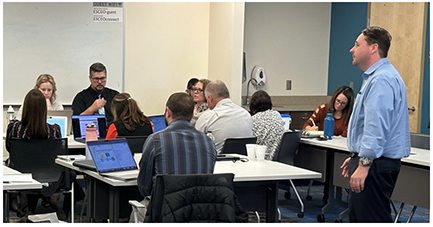
The ESCEO OLi4 PD program involves the adaptation of three major professional learning components: (1) centralized and regional professional development, which is being delivered in person at ESCEO offices; (2) online readings and activities, and (3) leadership performance coaching – a non-directive, non-judgmental approach to coaching. All three components are used as part of the statewide OLi4 program. Regional PD sessions allow participants to apply what they're learning through centralized PD, and learn from each other and as a cohort how to more effectively address common problems of practice in their schools and districts.
“The most important thing we're seeing in our building principals that are in OLi4 right now is their participation in that coaching piece; that is a critical part of it,” observed Lewis. “We work very closely with our coaches in helping determine the data they're using to identify needs and coaching our leaders on how to maintain focus on a small list of priorities – not 74 things we're going to work on this year – that are aligned to improving teaching and learning,” she added.

ESCEO has two staff members assigned as coaches to support principals in the program. They work in tandem with ESCEO Department of Teaching and Learning staff who are embedded in districts in the region. The format builds the capacity of ESC personnel to, in turn, build the capacity of districts to support inclusive leadership across school districts and across the region. Dr. Brandon Doubek, CEO of Evolution Alliance, and Dr. Rodney Harrelson, CEO of RTH Strategic Planning & Consulting, are part of the UC SDI OLi4 training team and provide the centralized and “regional” training. Mike Siebersma of Marzano Research provides PD and support for the coaches.
“Our coaches work very closely with our PD providers. We spend a lot of time with Rodney on really tailoring support to the needs of the participating districts that and I think it's super effective,” said Lewis. “It speaks to why we're getting the feedback we are, which is very positive, because it is reflecting the very specific needs of this area,” she added.
OIP and OLi4. “For those districts that have a DLT, BLTs, and TBTs, the connection with inclusive instructional leadership is already in place and that connection may have been in place through several superintendents and principals. The OLi4 PD we’re providing is a modified version and meant to start engaging districts in the region. Even if it's just the appetizer for some of them, it's a start,” said Hostetler.
Lewis elaborated:
The collaboration with Rodney has been wonderful. He has embedded a lot of collaboration within the PD; sometimes participants are working within their district team and other times they’re working with people from other districts who might hold the same position. It really just makes for a holistic, more tailored, experience as teams are moving through the process. And the only feedback we're getting is positive feedback because I think people are really internalizing some of the practices that we're trying to look at and implement. We keep hearing about the collaboration piece – ‘we love collaborating with our own district, we love collaborating with other districts’ – I think we've heard from all of our folks that they find it extremely valuable. So I think it really does allow for those connections to be made within the PD. So he isn't just delivering this great content and then saying, "good luck with it." It's really embedded in the process of the time we're together. And I think that makes a huge difference so that everybody has an understanding of what role they have in it. Maybe it isn't at the BLT level; maybe it's at the DLT level. And those conversations then can happen outside the PD sessions as well.
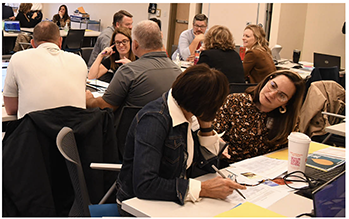
Hostetler credits SST Region 5, led by Michele Moore, with providing the support needed to ESC staff as well as districts to understand and use the OIP to support districtwide continuous improvement. “I have the best SST director in the state right here,” she said.
Hostetler looks for ways to support districts in her region to implement sustainable strategies for ensuring that evidence-based practices continue to be implemented system-wide, despite changes in leadership. “When you bring in OLi4 with the OIP, when you do that and you do that right, it's in your district forever,” she said. Becky Hornberger and Libby Wallick, who manage the OLi4 project at UC SDI agree: “OLi4 supports the OIP work that’s helping districts improve learning opportunities and outcomes for all students—and results are impressive,” commented Hornberger.
References
Ohio Leadership Advisory Council. (2022). A report of the work of the Ohio Leadership Advisory Council from 2007 to 2022: Identifying and implementing essential leadership practices needed by superintendents, district leadership teams, building leadership teams, and teacher-based teams to make and sustain improvements in districtwide instructional practice and student learning. Buckeye Association of School Administrators.
For more information about ESCEO and how its supporting leaders at all levels, contact: Traci Hostetler, EdD, Superintendent, ESC of Eastern Ohio, at t.hostetler@esceasternohio.org.
For more information about OIP and how it can be used to support adult and student learning, contact: Michele Moore, Director, SST Region 5, at michele.moore@sstr5.org.
For more information about resources to support districts, contact OLAC Director Mike Trego, or OLAC Consultant Jim Gay, PhD or Karel Oxley.